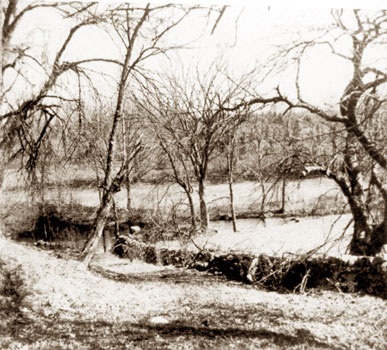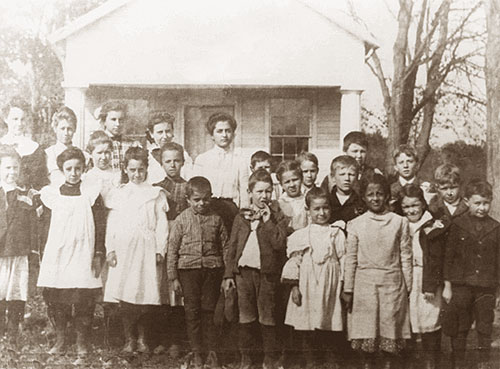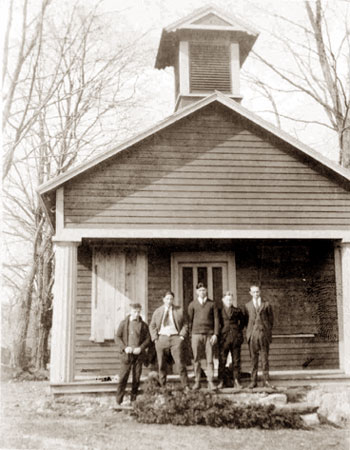A small white building about the size of a two-car garage roosts on a wedge of hill at the intersection of Roxbury and Long Ridge Rds.
This is the original one-room, one-teacher Roxbury School, where for more than a century, beginning around, 1800, youngsters in first through eighth grades learned their three Rs.
Step inside the door today and, instead of rows of school desks that gradually shrink in
size from the back to the front of the room, you see the big, flat-top desks of the Clark Realty Co.
Just up the road, but years away in time, stands the present Roxbury School, which has more rooms than the one-room school had pupils. Even with new classrooms added this fall—making a total of 35, if you count a teacher's room that had to be turned into a class room again—Roxbury is still straining at the seams. Its current enrollment has climbed to 1,072.
The sturdy little 18 by 33-ft. box with a peaked roof and two pillars flanking its porch is one of 10 single-room country schools that flourished in the northern part of Stamford during the 19th Century. What was it like to attend a school where children in eight different grades shared the same room and the same teacher?
Among the alumnae of the original Roxbury School are Mrs. Arthur Spiers (Olive Lock wood), 68, of Den Rd.; her sister-in-law, Mrs. William Spiers (Dorothy Clark), 64, of Wire Mill Rd., and Dorothy's mother, Mrs. Frank Downes '(Louise Baldwin), 88.
Recall Old Days.
"When we were little, we sat at the desks in front," said Olive Spiers. "As we grew bigger, we moved toward the back of the room. We had a pot-bellied coal stove, and the teacher shoveled coal or got one of the big boys to help."
"We brought our lunches, usually sandwiches and an apple," recalled Dorothy Spiers. "Instead of milk, we drank water from the spring, and all of us used the same dipper. We had an outhouse, of course, because there was no indoor plumbing."
"Our teacher was Mrs. Josephine Holly," said Olive. "She didn't spare the ruler. We learned reading, writing, arithmetic and geography, but I can't remember ever having any homework."
"I can remember the spelling bees, because I was a pretty good speller," said Dorothy. "All the children would stand up, and we'd spell one another down."
Wagon Ride.
"I had to walk two miles to school from where I lived then on Long Ridge Rd.," Olive said. "Whenever I could, I caught a ride on the grocer's horse-drawn wagon. As a school bus, it wasn't very reliable.
"An old lady named Hannah Knapp lived near where the Parkway is now," she continued. "Especially in winter, I used to stop at her house on the way home to get warm. Once she gave me some soup. I thought it was delicious until I found out it was turtle soup, and she had killed a turtle to make it."
"We seemed to have a lot of time to play, during lunch and recess," said Dorothy. "I used I to play jacks on the school porch."
Mrs. Downes exclaimed, "When I went to that school back in the '80's, I played baseball with the boys. The girls were too sissy. I can remember us used to shut our teacher, Mr. James McKean, in the big coal box when he went to get the coal. Then he would sing, and we'd let him out. I don't I think he was as strict as your Mrs. Holly."
Mrs. Downes' first husband was Richard M. Clark, foreman of the Advocate's advertising composing room from 1920 until his death in 1932. Before World War I, she worked for the Advocate as a linotype operator and proof reader.
New School.
When Martha Hoyt School (then called Willard) opened in 1914, little Roxbury School and the one-roomers at Turn-of-River, High Ridge and North Stamford were closed and their pupils transferred to the new school.
A few years later, probably around 1919, Roxbury School became a movie star. A film company arrived on the scene, painted the building red and I used it as the setting for a drama called "The Little Red School." Actress Martha Madison played the teacher.
Olive Spiers can remember watching prop men on the roof a pouring buckets of water to make motion picture rain.
For 10 years the little building retired from public life, and then it was opened as an art school by W. Langdon Kihn and John Ten Eyck. Now, in its role of real estate office, it undoubtedly contributes to crowding the classrooms of its successor up the hill.
Samuel E. Finch, who lives next door, owns the schoolhouse building. It stands half on his property and half on state property.
Eager Pupil.
Mr. Finch and his sister Dorothy, now Mrs. George Shields, were in the last group of pupils I attending the school before it closed. Dorothy at age four persistently sat outside on a rock and looked in the school window with such longing that the teacher finally let her come to school. Now Dorothy, herself, is a school teacher, in New Jersey.
Little Roxbury School has kept its original shape and its original site. Six of its sister schools are also still standing, but you probably wouldn't recognize them. Only three schools --Long Ridge, High Ridge and Simsbury (near Bull's Head)—were town down.
Scofieldtown School is the dining room and kitchen in the home of Mr. and Mrs. Laurence W. Lilienthal of Brookdale Rd. Some years ago, it was moved from Scofieldtown Rd. across the street to its present location.
Mrs. E. P. Brown (Amanda Burow) of Scofield town Rd. and her four brothers and sisters almost doubled the enrollment of this school when her family moved to Stamford in 1896.
"Before we came, there were only six pupils in the school," she said. "When they saw the five of us walking timidly up the road on our first day, the children were so glad to see us they rang the school bell.
Farms School has remained on its original site on Riverbank Rd. near Farms Rd., not far from the present Riverbank School. It is the living room in the home of Mr. and Mrs. George P. Soumakis.
Many Changes.
Hunting Ridge School on Hunting Ridge Rd. opposite Wildwood Rd. was sold at public auction in 1945 to a family who moved it to 42 Dannell Dr. and lived in it for a number of: years, almost as it was.
Now you wouldn't know it had' ever been a school. Its present owners, Mr. and Mrs. James P. Hoyt, who live around the corner at 5 Woods End Rd., have put on additions. The little school forms two bedrooms and the living room of a house the Hoyts rent to tenants.
Turn-of-River School, which I stood where the Turn-of-River firehouse is now, was moved in the '20s to 69 Turn-of-River Rd. It is a two-bedroom house, with kitchen, bath and a combination living-dining room.
Mr. and Mrs. Robert Dann rent it from its owner, Mrs. John McGowan of 5 Turn-of- River Rd. Mr. Dann's father, Herbert Dann, attended school in it when he was a boy.
The last one-room school to close was Bangall, at Westover and Roxbury rds. School kept there, believe it or not, until June, 1949. Now it is part of the Friends Meeting House at the same location. North Stamford School is the Guild House of the North Stamford Congregational Church.
Down through the years, as Stamford has continued to grow, the city's education problems haven't changed so very much. The same big burr—overcrowded schools—still clings to whatever group is in the school saddle.
For example, take this excerpt from a school board report: "The attendance of the schools is rapidly increasing and has again outstripped the school accommodations. For years past, the town has been building schoolhouses almost continuously and yet there is not a school building in the east, I west or south parts of town which is not overcrowded. . .The committee also recommends another addition to the High School."
The date of this report was 1913. Now, in 1964, the only difference is that schools are overcrowded in the north.



